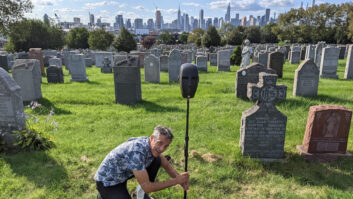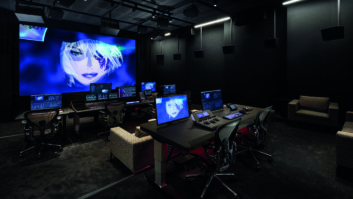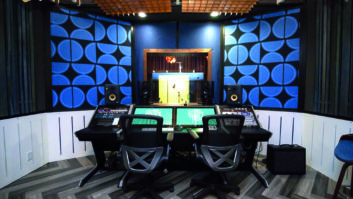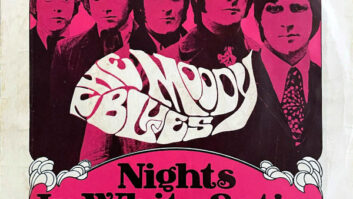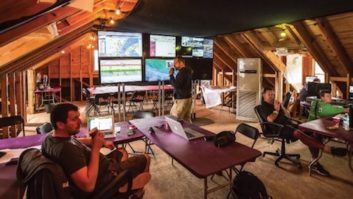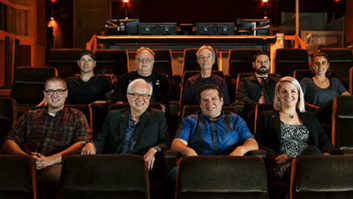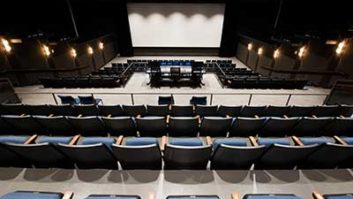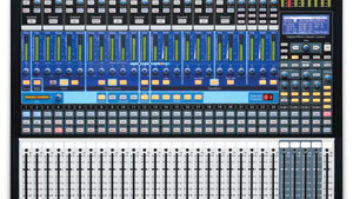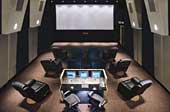
NT Audio’s patent-pending, state-of-the-art theater
Photo: Gary Galvin
The hottest place in Los Angeles to see and hear a movie isn’t open to the public. It’s NT Audio’s patent-pending state-of-the-art theater. That’s where quality control gets done on the 35mm soundtracks of some of Hollywood’s biggest movies, from The Lord of the Rings and The Last Samurai to The Passion of the Christ, Shrek 2, Spiderman 2 and I, Robot. With top-of-the-line Kinoton FP30 ECII projectors, dubbing stage — quality sound and La-Z-Boy — style seating for up to 15, well, it doesn’t get any better than this. It’s hard to believe, but QC’ing a major film is still a very demanding job. Now, thanks to NT Audio’s innovative theater that can simultaneously screen four sound formats, the job takes a lot less time than it used to.
As a company, NT prides itself on being quietly predictable. The bulk of its business isn’t glamorous; it’s the specialized, way-behind-the-scenes work of optical soundtrack recording. [See sidebar on page 82.] But in reality, the company is anything but predictable. In fact, its record of innovation is quite remarkable. Back in 1983, company founder Tom McCormick pioneered the use of half-speed recording for the film industry’s optical soundtracks. Until that time, half-speed recording was generally only used to master vinyl records, where it was known to improve frequency response. NT’s successful introduction of the process to film, and the consequent sonic improvement it created, became the cornerstone of the company’s business. Currently, NT is the world’s largest producer of optical soundtrack negatives.
NT was also instrumental in developing the process of recording all three current digital sound formats along with analog sound onto the same optical negative. This Quad recording process, which was first applied in 1995 on Twentieth Century Fox’s Die Hard With a Vengeance, was a huge innovation that enabled distributors to eliminate multiple-release print inventories.
It’s Quad recording that led to the development of NT’s patent-pending theater, an innovation that’s helping to simplify the lives of today’s overworked filmmakers. At the theater, not only can you check your print in the absolute highest-quality environment, but you can also check all four formats at the same time. It’s simple, but ingenious: Four people in separate sound environments can view the same projected image while independently A/B switching between film playback or master soundtrack elements. Each acoustically isolated listening room is capable of up to 6.1-channel monitoring, with the main theater equipped for 8.1-channel playback. Each room controls a custom audio router that allows instant switching between audio formats on the composite film print or the print master mix, which may be used for comparison. During listening, the digital soundtracks are also simultaneously checked for defects by computer programs monitoring the data error rates from the film playback.
Peter Bulcke, NT Audio’s COO
“This is the principle,” explains NT COO Peter Bulcke. “They see the same film while hearing a different soundtrack. The people monitoring the soundtrack in each room are also monitoring the QC software of each digital format. If they see spikes, they know something is wrong. But they also always listen. The software doesn’t show whether there is actually sound or not. If the master, for example, has perfect silence, the QC readout will say it’s perfect. You have to listen to know that the silence shouldn’t be there.”
In addition to the print that’s being quality-checked, a master soundtrack, in either hard drive or magneto optical disk format, is also synched up. If it’s suspected that something is wrong, then the master is auditioned for comparison.
Although the theater was designed to check audio, Bulcke notes, “We’ve done everything possible to get the best picture. The projector has a three-bladed shutter, which takes the strobe effect away for a very stable, clear picture, and daily we tune not only the audio, but also the projection systems.”
A normal theatrical projector has two sound heads. NT’s custom projectors have five — one for each digital format — and two analog readers. [Ed. note: Two analog readers are required due to the industry trend away from silver-striped analog soundtracks to more environmentally friendly magenta or cyan soundtracks. Silver soundtracks are read with white light, magenta or cyan with red. As both are currently in use, NT’s projectors accommodate both.]
The main theater’s B-chain comprises five JBL 5671 three-way cinema loudspeakers with an additional JBL 5641 low-frequency enclosure for L/Lc/C/Rc/R channels. Surround speakers are 10 JBL SP212A two-way cabinets with two Electro-Voice TL880D double 18-inch subwoofers. Amplification is by QSC DCA Series, with a Crest 8001 for subwoofers. Crossovers for all channels are Lake Contours. The three smaller QC rooms each contain six Genelec 1029As with Genelec 7070A subwoofer/bass-management systems.
The theater opened in January 2003 after a year of construction, and it’s been booked nonstop since. “Word of mouth went out very fast,” says Bulcke. “The first customer who listened called his mixer and said, ‘You’ve got to hear this!’ The mixer came in and said it sounded exactly like the mixing stage. They loved it.
“The fastest way they could previously QC was to book multiple theaters,” he continues. “They would, for example, check reel one in theater one. When they finished, it would go to theater two, and they’d start with reel two in theater one. They always had to move one print and they had to run it four times. If there was a mistake somewhere in the soundtrack while they went through all the stages, they lost all the time they’d spent. With us, they can do the job in a third or fourth of the time.”
Innovation hasn’t halted at NT. Early in 2004, the company introduced the first laser sound recorders to the Hollywood community. Based on state-of-the-art optical and DSP technology developed by NT during a three-year process, the laser recorders have now replaced the original half-speed process, resulting in an even more accurate image, improved high-frequency response and reduction of distortion. The lasers also provide extraordinary repeatability from negative to negative that conventional light valve technology has been unable to achieve.
“It’s just another extension of what we do here,” states Bulcke. “It’s a very innovative environment, basically because of Tom and the creative people he hires. He’s always encouraged them to bring their creativity into the workplace. We’re an engineers’ company, founded by an engineer, and we’re always changing and improving.”
Four Channels of Audio, One Piece of Film
Currently, 35mm release prints delivered for exhibition typically contain four soundtracks: Analog stereo, usually recorded with Dolby SR that can be matrix-decoded to play back in 4-channel surround, and three digital audio tracks — Dolby Digital, DTS and SDDS — which provide their respective 5.1-channel discrete mixes. Each system, although different in method of delivery, hardware and audio capabilities, shares the identical 5.1-channel printmaster mix as a source. Given the varied distribution of playback hardware throughout the world for the three digital audio systems, the major studios generally place all four sound formats on release prints, allowing individual movie theaters the choice of which format to use.
Once the post-production sound team completes the printmaster mix for a motion picture, the audio elements are given to the optical sound house to create the optical soundtrack negative, or OSTN. The OSTN is then sent to a film lab that aligns the OSTN with the corresponding picture negative and creates a composite print containing the combined picture and all soundtracks. Before release prints are made for theaters worldwide, the post-production sound team must approve all of the audio formats on the OSTN. Once the soundtracks have been checked, the OSTN is approved for printing and hundreds, or thousands, of release prints are made for local theaters.
